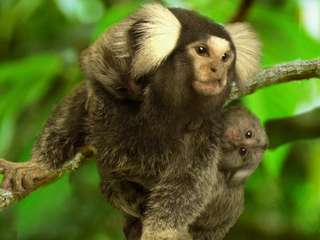Baylor researchers find genetic changes helped common marmosets successfully bears twins, other multiple births.
(Phys.org) —How can the tiny marmoset – a New World monkey – regularly successfully bear twins and sometimes triplets and quadruplets when much larger humans often face a difficult pregnancy and delivery?
The answer, said researchers led by those from Baylor College of Medicine in a report that appears online today in the journal Proceedings of the National Academy of Sciences (PNAS), rests with the genetic changes that arose as common marmosets (Callthrix jacchus) and other callitrichine monkeys evolved into the successful parents that exist in Central and South America today.
"We were really interested in learning much more about the marmoset for two reasons. One was to improve understanding of why they are so adept at gestating twins and rearing them successfully," said Dr. Kjersti Aagaard, associate professor of obstetrics and gynecology at BCM and corresponding author of the report. "If we knew their genetically encoded secrets, it might provide insights into complications arising from human twin births. Secondly, we also wanted to better understand on an evolutionary scale what drives them to rarely have singletons and nearly always have twins in the first place. The issue is hotly debated."
Dr. R. Alan Harris, the report's first author and assistant professor of molecular and human genetics at BCM, analyzed the recently completed genome sequence of the common marmoset together with other callitrichines and identified specific variations in four genes (GDF9, BMP15, BMP4 and WFIKKN1) that may play a role in the multiple ovulations occurring in these animals.
"Two things distinguish the marmosets – they produce multiples and they do it highly effectively and successfully," said Aagaard. "The genes most likely involved in multiple ovulations are only part of the amazing adaptations that have enabled them to do so."
Even after the infant marmosets are born, the differences are apparent, she said. Other females in the group will care for the newborns, carrying them on their backs as they traverse canopy forests, grooming them, and caring for them just as their biologic mother would. Often these "foster" females do not reproduce, leaving that to the "alpha" (dominant and birth) mother. Fathers and older siblings also care for these younger siblings, which is unusual in primates, said Harris.
"There is strong evidence that there's reproductive suppression at the behavioral and even the physiological level," said Harris. "There is usually only one reproductively active female in the group."
Another unusual facet of these animals is their small size, being the smallest monkeys in the primate world. The study also identified changes in the insulin like growth factor (IGF) genes that may be related to their size. "We and others have proposed that their small size has coevolved with their reproductive adaptations for twinning", explained Harris. "This coevolution may occur in relation to their habitats and feeding adaptations," Aagaard said. These unusual habits include insectivory and gumnivory (eating of primarily tree gum and insects), which is enabled by the unique clawed hands common to the callitrichine primates.
"Their reproductive adaptations pose an interesting question, particularly when you think about human biology and human pregnancy," she said. Human twin births are complicated by prematurity, a rare problem of identical twins known as twin-twin transfusion syndrome, and the potential resource limitations unique to one mother caring for two infants at the same time.
"The marmoset seems to have developed a series of truly amazing adaptations to get around these limitations," she said.
For example, one thing that might make their pregnancies more successful is a long lag time early in pregnancy, which allows the placenta to become well established. The marmoset spends nearly a third of their pregnancy investing in placental establishment and growth. That eliminates potential problems that result when placentas share connections and space in a single uterus (or womb) can become limited.
"We were very fortunate to have Dr. Tardiff of University of Texas at San Antonio and the Southwest Primate Center as a key partner on this work. She is one of the world's experts on marmoset biology, and has spent her life working on observing and deciphering the behavior and biology of these monkeys. Exploring the genetics underlying one of their most unique and fundamental traits—twinning—was tremendous fun and will yield important insights for human health in pregnancy."
"This study starts a process of looking at primates that are highly adaptive and successful in reproduction, and using them to jumpstart research into new avenues of thinking about human biology and reproduction," said Aagaard and Harris.
More information: Evolutionary genetics and implications of small size and twinning in callitrichine primates, R. Alan Harris, DOI: 10.1073/pnas.1316037111
Journal information: Proceedings of the National Academy of Sciences
Provided by Baylor University






















